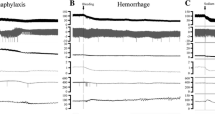Abstract
Response patterns of intestinal blood flow, oxygen extraction and consumption, blood flow distribution, and motility were assessed during intraarterial infusions of histamine, histamine after H1 or H2 blockade, dimaprit or dimaprit after H2 blockade. Histamine produced an initial peak response of blood flow with a slow decrease thereafter. Oxygen extraction was evenly depressed throughout the infusion, and oxygen consumption increased at the beginning. All initial responses were blocked by tripelennamine. Ranitidine, a new H2 antagonist, accelerated the decay of all responses. Dimaprit produced effects identical to those of histamine after tripelennamine. Distribution of blood flow was unchanged at the beginning of histamine infusion, but subsequently showed a shift to muscularis which was blocked by tripelennamine. Histamine usually stimulated intestinal contractions and this effect was abolished by tripelennamine. Thus, H1 stimulation, besides producing an initial vasodilation, increases oxygen uptake and redistributes flow to the muscularis.
Similar content being viewed by others
References
Folkow B, Haeger K, Kahlson G: Observations on reactive hyperaemia as related to histamine1 on drugs antagonizing vasodilation induced by histamine and on vasodilator properties of adenosine triphosphate. Acta Physiol Scand 15:264–278, 1948
Ash ASF, Schild HO: Receptors mediating some actions of histamine. Br J Pharmacol 27:427–439, 1966
Black JW, Duncan WAM, Durant GJ, Ganellin CR, Parsons ME: Definition and antagonism of histamine H2 receptors. Nature 236:385–390, 1972
Schwaiger M, Jacobson ED: Peripheral vascular H2 receptors to histamine. Circ Shock 6:213–221, 1979
Pawlik W, Tague LL, Tepperman BL, Miller TA, Jacobson ED: Histamine H1- and H2-receptor vasodilation of canine intestinal circulation. Am J Physiol 223:E219-E224, 1977
Banks RO, Fondacaro JD, Schwaiger MM, Jacobson ED: Renal histamine H1- and H2-receptors: Characterization and functional significance. Am J Physiol 235:F570-F575, 1978
Parsons ME, Owen DAA, Durant GJ, Ganellin CR: Dimaprit (S-(3-(N,N-dimethylamino)propyl)isothiourea)—a highly specific histamine H2 receptor agonist. I Pharmacology. Agents Actions 7:31–37, 1977
Flynn SB, Johnston BM, Owen DAA: The cardiovascular response to dimaprit, a selective histamine H2-receptor agonist. Br J Pharmacol 61:101–107, 1977
Branshaw J, Brittain RT, Clitherow JW, Daly MJ, Jack D, Price BJ, Stables R: Ranitidine (AH 19065): A new potent, selective histamine H2-receptor antagonist. Br J Pharmacol 66:464P, 1979
Daly MJ, Humphray JM, Stables R: Antagonism of vasodepressor and gastric secretory responses to histamine by ranitidine and cimetidine in the anaesthetized dog. Br J Pharmacol 67:414P, 1979
Shepherd AP, Burgar CG: A solid-state arteriovenous oxygen difference analyzer for flowing whole blood. Am J Physiol 232:H437-H440, 1977
Miller TA, Tepperman BL, Tague LL, Pawlik W, Jacobson ED: Characteristics of H2-receptor blockade in the canine mesenteric circulation. J Surg Res 27:119–123, 1979
Flynn SB, Owen DAA: Histamine receptors in peripheral vascular beds in the cat. Br J Pharmacol 55:181–188, 1975
Guth PH, Smith E: Histamine receptors in mesenteric circulation of the cat and rat. Am J Physiol 234:E370–374, 1978
Johnston BM, Owen DAA: Tissue blood flow and distribution of cardiac output in cats: Changes caused by intravenous infusions of histamine and receptor agonists. Br J Pharmacol 60:173–180, 1977
Richardson PDI: Drug-induced changes in capillary filtration coefficient and blood flow in the innervated small intestine of the anesthetized cat. Br J Pharmacol 52:481–498, 1974
Schwaiger M, Fondacaro JD, Jacobson ED: Effects of glucagon, histamine and perhexiline on the ischemic canine mesenteric circulation. Gastroenterology 77:730–735, 1979
Varro V, Jung I, Szarvas F, Csernay L, Savay G, Okros J: The effect of vasoactive substances on the circulation and glucose absorption of an isolated jejunal loop in the dog. Am J Dig Dis 12:46–59, 1967
Chou CC, Grassmick B: Motility and blood flow distribution within the wall of the gastrointestinal tract. Am J Physiol 235:H34-H39, 1978
Walus KM, Fondacaro JD, Jacobson ED: Hemodynamic and metabolic responses to increased intestinal motor activity. Gastroenterology 78:1287, 1980
Author information
Authors and Affiliations
Additional information
These investigations were supported in part by USPHS grant #AM20540.
Rights and permissions
About this article
Cite this article
Walus, K.M., Fondacaro, J.D. & Jacobson, E.D. Mesenteric vascular reactivity to histamine receptor agonists and antagonists. Digest Dis Sci 26, 438–443 (1981). https://doi.org/10.1007/BF01313587
Received:
Revised:
Accepted:
Issue Date:
DOI: https://doi.org/10.1007/BF01313587




